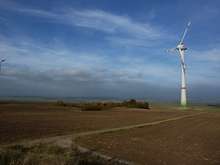The recent IWES study on a 100 percent supply of renewable power implicitly expects Germany to increase the share of wind power from 15 percent fewer turbines, with overall power consumption remaining basically unchanged. What would that look like?

Common wisdom has it that, as the mayor of Tübingen, Boris Palmer, recently put it (see the English version from this climate-denial website), “We need to double the number of currently 25,000 wind turbines in order to supply Germany.” The IWES study came to a much different conclusion. Is it feasible?
Let’s do a quick back-of-the-envelope calculation – or, if you are German, you can put it on your Bierdeckel.
At the end of 2013, Germany had 23,645 wind turbines with a total installed capacity of around 33.7 GW. Let’s simplify the average to 1.5 MW per turbine.
That figure includes a lot of the old, smaller stuff, however. In the first half of 2014 (PDF), for instance, Germany installed 650 wind turbines with a total capacity of around 1.7 GW, nearly 3.0 MW per turbine – roughly twice the historic average.
The total for mid-2014 is therefore around 24,900 turbines with a total capacity of 35.4 GW, equivalent to 1.42 MW per turbine. This roughly 1.5 MW per turbine covered 10 percent of power supply in the first half 2014, with around 25,000 turbines standing.
One obvious way of increasing power production would be to increase generator size sixfold. Unfortunately, this approach would require the average turbine size to grow to 9.0 MW, a size not yet even built as a prototype. Although the first model was built in 2007, Enercon’s 7.5 MW E126 still has the greatest capacity of any wind turbine ever built.

The other option is to increase swept area by using longer rotor blades. This increase is then not measured in megawatts, but in a greater capacity factor. The study provides us with estimates of future capacity factors for both onshore and offshore wind, so we could back-calculate the average generator size in MW from the number of GWh from the MW installed. The study gives us an estimate for installed MW, just not in the background document we have focused on. Ladies and gentlemen, I present you with the 24-page summary (PDF in German).
We know that the current capacity factor for all wind turbines in Germany is no more than 20 percent. For onshore wind, that is expected to increase by 50 percent to 30 percent, while the CF of offshore is expected to continue at the current rate of 44 percent.
Nearly 4,000 of the 21,349 turbines in the scenario would be offshore, nearly a fifth. At present, the average offshore turbine
is roughly 20 percent bigger than the average onshore turbine newly installed. For instance, on Friday the 80th and last turbine was installed at the DanTysk wind farm in Germany, where 3.6 MW turbines are used. The turbines used at London Array have the same generator size.
Hence, a fifth of future turbines would produce more than twice as much power because of generator size and again more than twice as much power because of the greater capacity factor, but that is not quite as sixfold increase. The remainder would have to come from even greater generator sizes, which is not unlikely; 5MW may soon be the standard for offshore wind turbines. But the study assumes an average of 10 MW per offshore turbine, a size still only on the drawing board.
The situation looks different for onshore. Here, the capacity factor is assumed to be 50 percent greater in the future; a sixfold increase would be 500 percent greater with the same amount of installed MW. Generator capacity would therefore have to increase fourfold for a sixfold increase in MWh, putting the average onshore turbine size close to 6MW. The study assumes 5MW per onshore turbine.
As the example of the E126 shows, even bigger sizes are feasible onshore, so this finding is not impossible. Whether it is plausible or not is perhaps a matter of opinion. And the situation get even less plausible when we talk about storage — but let’s save that for tomorrow.
One question still remains, however. IWES’s interactive map states that a whopping 56,594 GWh of wind power would be “excess” in the scenario, which I assumed to mean lost because stored electricity as reported separately. If so, this 100 percent renewable power supply would lose as much wind power as Germany now generates.
Source: Renewables International. Reproduced with permission.











